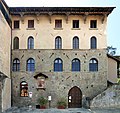Pescia
| Pescia | ||
|---|---|---|

|
|
|
| Country | Italy | |
| region | Tuscany | |
| province | Pistoia (PT) | |
| Coordinates | 43 ° 54 ' N , 10 ° 41' E | |
| height | 62 m slm | |
| surface | 79 km² | |
| Residents | 19,574 (Dec. 31, 2019) | |
| Population density | 248 inhabitants / km² | |
| Post Code | 51017, 51012, 51010 | |
| prefix | 0572 | |
| ISTAT number | 047012 | |
| Popular name | Pesciatini | |
| Patron saint |
Santa Dorotea (February 6th) |
|
| Website | www.comune.pescia.pt.it | |
 Center of the city of Pescia |
||
Pescia [ ˈpeʃːa ] is an Italian municipality ( comune ) with 19,574 inhabitants (as of December 31, 2019) in the province of Pistoia , Tuscany .
description
The municipality of Pescia is famous for its flower market and for the adventures of Pinocchio ( Carlo Collodi ). It lies between Lucca and Florence and has an area of 79 km². The city is on the banks of the Pescia River .
There are two residential centers in the city, the first for public life on the left bank of the river and the second for religious life on the right bank of the river. In the first there is the castle and the square and in the second there is the cathedral.
The municipality of Pescia also includes a few small villages in the Pescia Mountains. Jean-Charles-Léonard Simonde de Sismondi called the Pesciatine mountains “Pesciatine Switzerland” because these mountains resembled his Swiss mountains. All of these villages are similar: they all have (or had) a city wall, a small church and a tower which became the steeple . These villages are called: Medicina, Fibbialla, Aramo, San Quirico, Castelvecchio, Stiappa, Pontito , Sorana, Vellano and Pietrabuona. Other villages in the municipality are Collodi , Veneri, Alberghi and Chiodo.
The community's assets are: growing flowers ( carnations ) and making paper . Pescia is famous all over the world for its flower production and sale of flowers (it is called "the city of flowers"), the city has particularly good relations with Belgium . The tradition of paper making is very old and many paper mills still produce quality paper and sell it across Italy. The Museum of Paper is located in Pietrabuona .
Pescia is the seat of the diocese of Pescia . The main church is the Cathedral of Maria Santissima Assunta e di San Giovanni Battista .
history
After some archaeological excavations, archaeologists think that the Lombards built the first settlement here. The city's name, Pescia, came from a Longobard word that meant "river".
Lucca attacked Pescia and destroyed it in the 13th century, but the Pescia people quickly rebuilt the city. During the Middle Ages, Florence and Lucca fought over the city because their independent state lay between the borders of the two republics. After Pisa tried unsuccessfully to occupy Pescia, Florence conquered it.
City assets were mulberry tree cultivation and silkworm breeding . It is said that the silkworm was brought to Europe for the first time by a Pesciatine monk from the Far East.
At the end of the 17th century the Grand Duke of Tuscany named Pescia "City of the Grand Duchy of Tuscany". The passage of Napoleon Bonaparte badly damaged the city's economy because he exchanged the silk for the sugar beet .
The bombings of World War II damaged Pescia, but the city quickly recovered. The new flower market was set up and the worldwide sale of flowers began.
Attractions
The most important buildings in the city are the Palazzo del Podestà (with the plaster cabinet Gipsoteca Libero Andreotti ), the Palazzo del Vicario (seat of the local government), the cathedral and the library. Another most important building is the Old Flower Market (1951) due to its modern architecture. In the district of Pietrabuona there is the Museum of Paper ( Museo della Carta ). A special attraction is the Villa Garzoni in Collodi with its baroque gardens, cascade , grottos and numerous garden sculptures. A butterfly house is another attraction of the garden ensemble, which not only houses butterflies and plants, but also turtles , zebra finches and rose heads . The Parco di Pinocchio is also in Collodi.
In the "Teatro Pacini " theater
Garden of Villa Garzoni
education
Pescia is an important school center in its area. There are three vocational schools in the city: an accounting school, an agricultural school and a graphic-tourism vocational school. There are also four grammar schools: a humanistic, a mathematical-scientific, a psycho-pedagogical and a modern-language grammar school.
politics
mayor
- Oreste Giurlani has been the mayor since May 27, 2014. He replaced Roberta Marchi, who had been mayor since June 2009.
Town twinning
Partner municipalities of Pescias are
|
Personalities
Honorary citizen
- Giovanni De Vivo (1940-2015), Bishop of Pescia (1993-2015)
Daughters and sons of the city
- Benedetta Carlini (1590–1661), born in the district of Vellano, nun, abbess and mystic
- Vincenzo Olivicciani , called "Vincenzino" (1647–1726), singer (soprano castrato)
- Libero Andreotti (1875–1933), sculptor
- Gino Birindelli (1911-2008), NATO - Admiral and neofascist politician
- Enzo Martinelli (1911–1999), mathematician
- Giampaolo Pazzini (* 1984), football player
Web links
Individual evidence
- ↑ Statistiche demografiche ISTAT. Monthly population statistics of the Istituto Nazionale di Statistica , as of December 31 of 2019.
- ^ Website of the Museum of Paper in Pietrabuona , accessed on June 18, 2019 (Italian)
- ^ Website Pescia - Il Sindaco , accessed on November 21, 2016
- ^ Pescia e le Città gemellate











